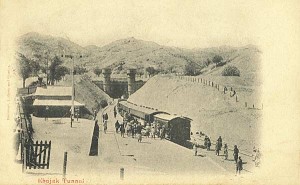At a model railway show I picked up a copy of Soldier with Railways, the autobiography of Tony Mains, a British railway enthusiast and army officer who travelled extensively in India. Mains was an intelligence officer in Iraq during World War II, and his book also describes various trips by rail from Basra to Turkey, Syria and Beruit.
The chapter describing his time in Baluchistan in 1944-46 gives a history of the railways to the Afghan border at Chaman in (what is now) Pakistan, and this description of traffic:
The station at Chaman was literally on the frontier, and near by were a number of sheds, which, rumour had it, contained the material to extend the line to Kandahar in the even of a fourth Afghan War. There was a heavy traffic in fruit brought by by lorry from Kandahar, and dispatched onward in ice bunkered wagons, necessitating a daily special good train. The supply of wagons was never adequate for the traffic offering, and the hubbub created by the arguments this engendered could be heard all over the cantonment. There is no doubt that the railway staff benefited greatly from this, and the story was current that the North Western Railway administration used to post a very senior Station Master to Chaman to enrich himself in his last year of service.
Soldier with Railways, by Lt Col A A Mains (Picton Publishing, 1994) pp101-102

The Chaman Extension Railway from Bostan Junction on the line through the Chapar Rift to Chaman on the Afghan frontier was opened 30 September 1891. The broad gauge line’s summit is at over 6000 ft, and the route passes through the Khojak tunnel through the Khwaja Amran range. The rails stopped 5 km beyond Chaman fort, and just 200 m short of the border with Afghanistan as fixed by Sir Mortimer Durand in 1893.
A supply depot at Chaman contained the rails, sleepers and bridge parts which would be needed to extend the line the remaining 108 km to Kandahar in the event of a military emergency. Meanwhile the Russians were thought to be storing similar materials at Kushka to allow the rapid construction of a line to Herat if they thought there was an emergency!
I met with unbounded civility and hospitality from everybody in Quetta as well as at Chaman, our most north-westerly point on the Afghan boundary. For those who believe in the unpreparedness of England, it may be stated that, from this point, we could with ease lay a railroad to Kandahar in less than three weeks.
Across Coveted Lands, Or a Journey from Flushing (Holland) to Calcutta, Overland by A Henry Savage Landor (Macmillan & Co Ltd, 1902)
An extension of the Chaman line at least as far as Spin Boldak has often been proposed in subsequent years, but doesn’t seem to have made much progress.
Pakistan and Afghanistan are expected to enter in to a new trade and economic cooperation mechanism during the President of Pakistan first official visit to Afghanistan on January 7, 2009, official sources told Daily Times on Friday.
…
Extension of railway link between Chaman-Spin Boldak is expected to be deliberated in the visit as this issue was discussed in 2006 for establishing better communication and development of physical infrastructure, which will help in enhancing trade facilities between the two countries.
Source: President’s first official visit: Pakistan, Afghanistan to ink new trade agreements, Daily Times, 2008-12-27.
